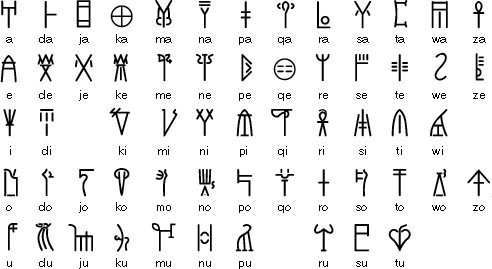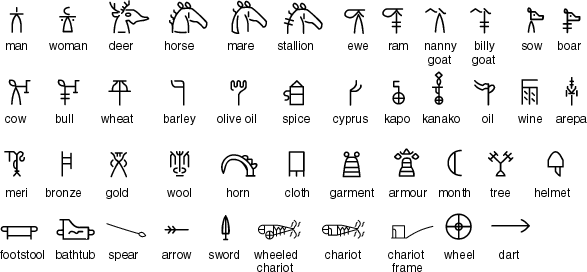Linear B
In 1900 the archaeologist Sir Arthur Evans (1851-1941) discovered a large number of clay tablets inscribed with mysterious symbols at Knossos on Crete. Believing he had discovered the palace of King Minos, together with the Minotaur's labyrinth, Evans dubbed the inscriptions and the language they represented as 'Minoan'.
Evans spent the rest of his life trying to decipher the inscriptions, with only limited success. He realized that the inscriptions represented three different writing systems: a 'hieroglyphic' script,Linear A and Linear B.
The hieroglyphic script appears only on seal stones and has yet to be deciphered. Linear A, also undecipherable, is thought to have evolved from the hieroglyphic script, and Linear B probably evolved from Linear A, though the relationship between the two scripts is unclear.
Evans figured out that short lines in Linear B texts were word dividers. He also deciphered the counting system and a number of pictograms, which led him to believe that the script was mainly pictographic. Evans also discovered a number of parallels between the Cypriot script, which had been deciphered, and Linear B. This indicated that the language represented by Linear B was an ancient form of Greek, but he wasn't prepared to accept this, being convinced that Linear B was used to write Minoan, a language unrelated to Greek.
In 1939, a large number of clay tablets inscribed with Linear B writing were found at Pylos on the Greek mainland, much to the surprise of Evans, who thought Linear B was used only on Crete.
Michael Ventris (1922-56) was the person who eventually deciphered Linear B in 1953. His interest was sparked in 1936 on a school trip to an exhibition about the Minoan world organised by Arthur Evans. For the next 17 years, Ventris struggled to understand Linear B. At first he was skeptical that the language of Linear B was Greek, even though many of the deciphered words resembled an archaic form of Greek. Later, with the help of John Chadwick, an expert on early Greek, he showed beyond reasonable doubt the Linear B did indeed represent Greek.
Linear B was used between about 1500 and 1200 BC to write a form of Greek known as Mycenaean, named after Mycenae, where Agamemnon is said to have ruled. It . The Linear B inscriptions, most of which were accounting records listing materials and goods, are the earliest known examples of written Greek.
Linear B syllabary

Linear B logograms
These logograms stand for whole words and mainly represent items that were traded. As Linear B was used mainly for recording transactions, this is not surprising. Some of the logograms resemble the things the represent, so could be called pictograms. Not all the logograms have been deciphered.

Thanks to the website: Omniglot, for the above information.
The following is taken from Charles Pellegrino's Unearthing Atlantis (pages 233-246).
One other piece of the jigsaw puzzle, only recently brought to light, provides a glimpse of life under the pall of volcanic winter, and can be dated with reasonable assurance to the time of the Thera upheaval.In China, during the Minoan Linear A Period, records were written on strips of bamboo. Fourteen hundred years later, all such strips that had survived to the reign of Emperor Qin were recognized as priceless treasures and, probably under orders from the emperor himself, were compiled and copied by scribes copied so many times that survival of China's past into its future was virtually guaranteed. The ancient texts state that "in the twenty-ninth year of King Chieh [the last ruler of Hsia, the earliest recorded Chinese dynasty], the Sun was dimmed . . . King Chieh lacked virtue . . . the Sun was distressed . . . during the last years of Chieh ice formed in [summer] mornings and frosts in the sixth month [July]. Heavy rainfall toppled temples and buildings.... Heaven gave severe orders. The Sun and Moon were untimely. Hot and cold weather arrived in disorder. The five cereal crops withered and died."
The bamboo annals further record that floods and ice were followed by seven years of drought lasting into the beginning of the Shang dynasty. A great famine broke out, and in the northern provinces man became a man eater. The Chinese scribes did not provide precise dates for these events; but they did footnote their royal genealogies with listings of eclipses and other astronomical phenomena. During 1990 and 1991, NASA/JPL astronomer Kevin Pang carefully tracked China's dynasties backward through time, using as probes the predictable motions of heavenly bodies to derive such precisely dated events as the lunar eclipse of January 29, 1137 B.C.which, though not dated by the scribes, was said by them to have occurred during the thirty- fifth year of King Wen.
King Chei lived at the same time as T'ang (the first king of the Shang dynasty), which, according to the scribes, was sixteen generations before King Wen. Because the Chinese considered a generation to be thirty years long, one can infer that Chieh ruled about 480 years before Wen, around 1617 B.C., plus or minus a decade or two. Armed with additional eclipse dates for 1876 B.C. (twenty - five generations before Wen) and 1302 B.C. (five generations before Wen), Kevin Pang plotted the eclipses on a graph, fitting a curve through them and locating the point that, according to Chinese history, places Chieh sixteen generations before Wen.
"We find the date is again [in the range of] 1600 B.C.," says Pang, "plus or minus thirty years. Thus the historical records confirm what was suggested by the ice cores, tree rings and older radiocarbon dates that Thera [exploded] late in the seventeenth century B. C. "
Given such evidence, I think the archaeologists will eventually come around. One thing is certain: these are exciting times for astronomers, glaciologists and paleontologists to be poking our noses into the field. Resetting dates tends to ruffle a few feathers, but Cretan and Theran scholars haven't put up any serious resistance. People have not been studying the Minoans for very long: the civilization was only discovered during the past century, and there has not been enough time for opinions to become deeply entrenched.
I think all of this is very interesting. I hope you think the so too. It makes a change from reading about Greek politicians and what they are doing with other people's money.
Minoan history is very close to my heart. Of course, I have my own theory of how the Minoan Civilization met its end. You can read my theory in Tears from the Sun - A Cretan Journey, which is available from Amazon. Check it out.
And should you have read my book, maybe you would like to follow me on Face Book. Take a look at my fan page, Tears from the Sun - Jane Sharp and please click 'like' if you do.
That's all for today, I'll be back with more Cretan news, tomorrow.
Love and Hugs,
Jane x

No comments:
Post a Comment